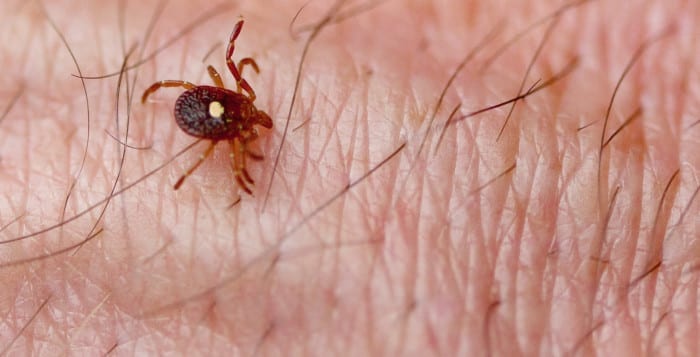Here we are, in a new year, and I am going to start off with a cautionary tale. I was just about to take a shower when I felt a small bump on my left thigh. I thought that was strange since I hadn’t before felt anything there but it was just beyond my view as I fingered the spot and craned my neck to try and see. Then, to my amazement, the bump came off in my hand, revealing itself to be a tick. Ugh!
The legs were moving so it was clearly alive and rather large, so I guessed it was a dog tick. With wonderful coincidence, I happened to have an appointment with the dermatologist that afternoon, so I put the tick into a little plastic baggie and brought him this present. Although I half expected him to just throw it away, he in fact filled out the paperwork and sent it to a lab.
Now I am sharing this with you because I suspect that, like me, you thought tick season had ended with the start of winter. I even stopped putting Frontline on my golden retriever, figuring any ticks would have gone into hibernation or been killed off by the colder weather. But I should have realized that the calendar and the weather aren’t always in sync. We have been enjoying fairly mild temperatures for this time of year and, as it turned out, so have the ticks.
Now I don’t know if the tick fancied me rather than my dog, or if he just found me as I was walking across the lawn or brushing against a bush while putting out the garbage. However it happened, I was, so to speak, stuck with him until that lucky moment when my fingers brushed against his body. Anyway, I got a call from the doctor four days later with the surprising news that despite its large size, the critter was an engorged deer tick.
Not good. We all know that deer ticks can carry Lyme disease and transmit it to humans when they suck up to you. We have had several deer sightings in the neighborhood, especially around a wooded piece of property nearby. To me they are beautiful, graceful animals, and I watch them with admiration as they run. But I certainly don’t appreciate the bugs they can bring and leave behind as a souvenir of their visits.
The doctor asked me if I preferred waiting for the blood test, six weeks away, to determine if in fact I had been infected or if I wanted to go on the antibiotic regime immediately. I chose the latter and began taking 100 mg of doxycycline, with lots of water but no food as seriously instructed, every 12 hours. But the story doesn’t end there.
After only two pills, I developed a headache that just wouldn’t quit. This is apparently a not uncommon side effect with this medicine. So I was then transferred to 500 mg of amoxicillin three times a day for at least 20 days and advised also to take a daily probiotic, though not within two to three hours of each other, and to eat lots of yogurt. As we know, that only partially works to offset the distress to the gastrointestinal tract that accompanies regular doses of antibiotics. Plus I have broken out in splotches of itchy rashes, another unhappy side effect.
Bottom line: A tick bite can be a nasty thing, bringing along all sorts of minor and even major miseries. So from my experience, I hope you will check your skin regularly, even hard to see places, and not assume that a tick is just another summer pest.
Oh, by the way, Happy New Year!





